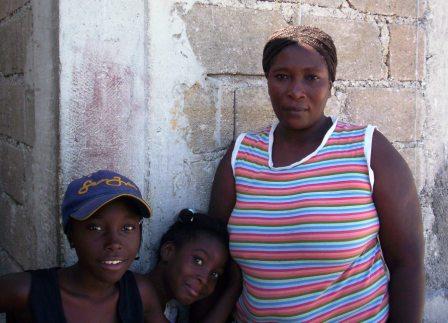Zilmit sells household items in the market in Gonayiv. She sits behind a patch of sidewalk, with careful piles of pots, pans, dishes, glasses, and cups arranged in front of her. It’s the beginning of the school year, so she extends her business to sell school wares as well. Colorful backpacks, book bags, and lunch boxes hang on a fence behind where she sits.
By September 2004, Zilmit had already been a member of Fonkoze for two years. On Wednesday, September 15th, she received a new credit for 12,000 gourds, or about $300. On Thursday, she went to Port au Prince to buy merchandise. She returned to Gonayiv early on Friday, as a storm was starting. By late evening, the water was rising in her home. As it reached her knees, then her hips, then her chest, she knew that she and her little boy had to flee. They ran to a neighbor’s house and climbed onto the roof. From there, they watched as the water swept their belongings away. Her merchandise disappeared with everything else she own.
Hurricane Jeanne devastated Gonayiv. It’s said that 250,000 lost their homes. Flood waters rushed down the mountains that surround the city. Those mountains are utterly bare. Not a tree remains. Plant life, with the topsoil that could have held some of the cascading water, has long been torn away. The slopes give the city and its surroundings the appearance of a large, porcelain bowl. It’s easy to imagine how the torrents of rainwater must have rushed in from all sides. The shallow new lake that the hurricane created just south of the city remains two years later.
Zilmit was ruined. She and her son escaped with nothing but the clothes on their backs.
For the first months after the flood, she could do nothing. It was all she could do to get her hands on the food, clothes, and water that she and her boy needed to live. She could make no repayments on the loan she had taken, because she had no merchandise to sell and no money to buy new merchandise with. She spent the time clearing the mud from her house and replacing the roof that the flood washed away.
Fonkoze contacted Zilmit shortly after the flood to see how she was doing. When she was ready to go back to work, Fonkoze lent her another 12,000 gourds for twelve months with no interest, and cancelled the interest on the first 12,000 gourds. She was able to rebuild her business, and now she’s repaid both of the loans.
Madanm Awòl Jeune had already been a Fonkoze client for three years when the flood hit. She sells foodstuffs – rice, beans, sugar – by the sack or in smaller quantities, working from a small room in a building in the same yard where she has her home.
She too lost everything in the flood, having to flee from her home with her five children. Shortly after the six of them escaped to a neighbor’s cement roof, the waters in and around the house they abandoned were more than six feet deep. The family had no drinking water, no food, no clothes. When Madanm Awòl returned to her shop the Monday after the storm, she simply threw everything away. Not a scrap of unspoiled merchandise remained.
That Monday, she and her children had to leave the roof where they had spent two days. They eventually settled at a friend’s home, where they lived on a porch while they worked to reconstruct their lives.
Fonkoze worked with them. Not as an aid agency, but as a partner. When Madanm Awòl was ready to re-establish her business she received an interest-free loan, just like the one that Zilmit received. Fonkoze cancelled the interest on her outstanding debt and stretched out the repayment schedule, giving her a year rather than the usual six months. Like Zilmit, Madanm Awòl has repaid her loans and once again has a business that ensures a livelihood for her children and herself. She’s moved back into her house, though she says that, occasionally, little clumps of mud that she and her children failed to remove still fall from the ceiling of their small home.
By lending the flood victims money, Fonkoze went against all sorts of conventional wisdom. Generally speaking, disaster victims get well-intentioned aid . . . if they get any help at all. Most would assume that such women, left without assets that could be used as collateral, left without much of anything at all, would not be creditworthy. It would be easy to assume that such women would have very little chance of repaying a loan. Those who make such assumptions could tend to think that they are only being realistic.
But the reality turns out to be rather different from what such realists might think. For poor women whose livelihoods depend on the small businesses they run, access to relatively inexpensive credit is crucial. Poor women repay their micro credit loans at rates that commercial banks, with their well-to-do borrowers, can only dream of. Their desire to qualify for the next loan, to make their businesses grow, to improve their families’ lives is all the motivation that they need.
It’s not that the formula for success is simple. Fonkoze has Gonayiv customers who continue to suffer the consequences of the flood. Mirlande, for example, used to sell cosmetics and other notions in Passe Reine, a short way out of Gonayiv on the road north to Okap. She spent the night of the flood standing with other adults in chest-high water in her house. They put the children in the ceiling rafters. Most of her neighbors were forced to flee to a nearby church, but her house was saved when the house next to it was washed entirely of its foundation. The waters pushed the one house into the other, creating a barrier that protected the folks who were in her house from the worst of the flood.
Mirlande too lost almost everything in the flood: her clothes, her livestock, her merchandise, and 15,000 gourds, or about $375, that she had saved up so that she could buy more goods to sell. But unlike the other women, Mirlande has not really recovered. She received the same interest-free Fonkoze loan that the other women received, but two years after the flood her business still does not exist.
Part of the problem is that when she received that new loan, she used it to buy household items that she felt she needed. She surely did need them, but their purchase ensured that the money she borrowed would not be used to generate income. She thus lost any chance to rebuild her business, let alone to repay her loan.
But the lesson to draw from Mirlande’s story is not that flood victims cannot make good use of credit. The stories of Zilmit and Madanm Awòl would counter such a claim. And theirs are not the only happy stories I could relate. The lesson is, rather, that one must work with flood victims to help them ensure that they use their credit well. For Fonkoze, this is a work in progress. Just as Zilmit and Madanm Awòl are just two exemplary success stories, Mirlande is only one example out of many as well.
But the story of Mirlande and of other women who are still in trouble is not over, and Fonkoze will continue to try to work with them in whatever way it can. It’s not yet time to call the loans made to such women a failure.










